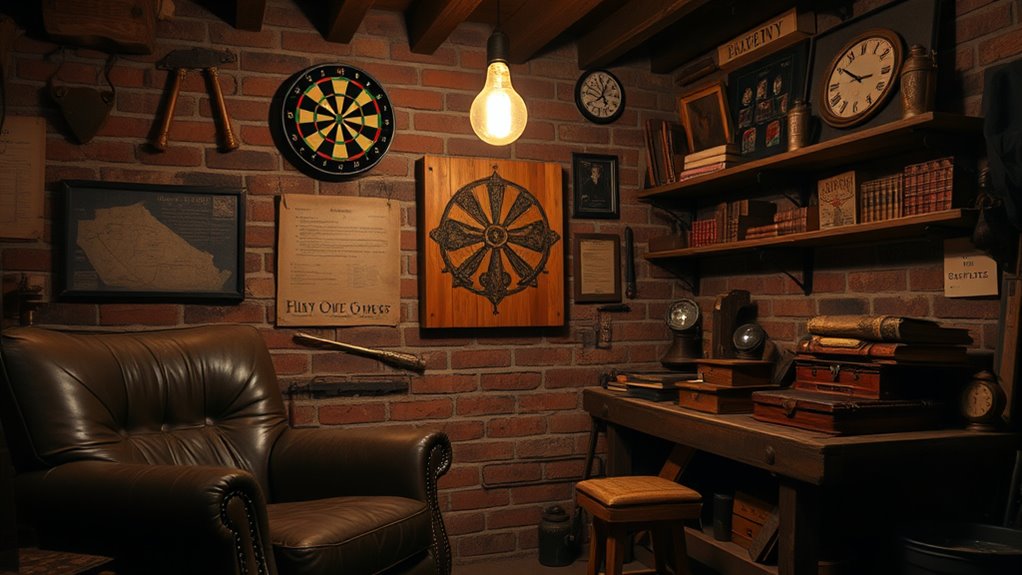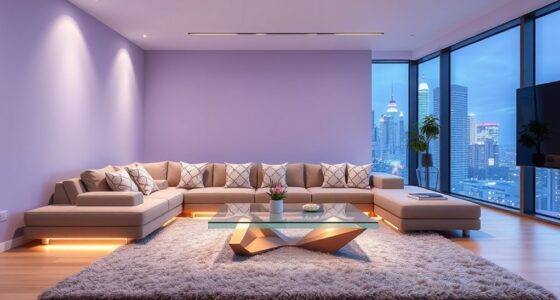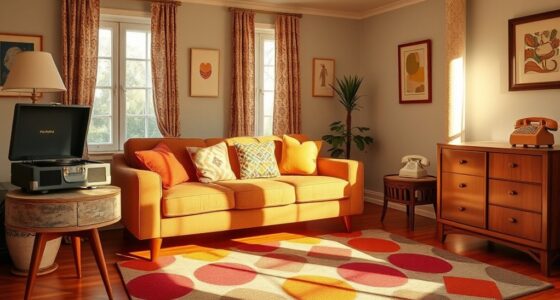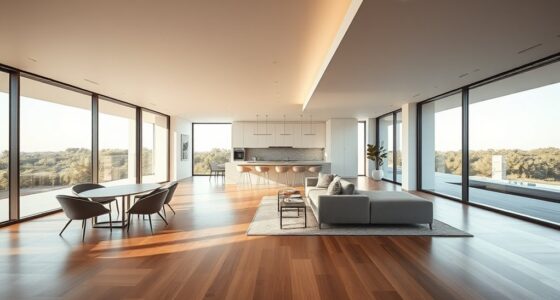The concept of the man cave is older than you might think, dating back to ancient civilizations where wealthy individuals created private spaces for relaxation, reflection, and strategy. During medieval times, hidden chambers in castles provided safety and privacy, while Renaissance libraries fostered learning and curiosity. Over time, technological advances transformed these spaces into personal retreats, evolving into the modern man cave that reflects your personality, interests, and cultural influences. Discover more about its fascinating history and evolution below.
Key Takeaways
- Ancient civilizations created private retreats like gardens and ceremonial chambers for reflection, strategy, and personal identity.
- Medieval castles included hidden chambers and secret passages used for safety, privacy, and strategic purposes.
- Renaissance studies and libraries served as personal spaces for learning, debate, and intellectual curiosity.
- Cultural rituals worldwide, such as Japanese tea rooms and Middle Eastern courtyards, influenced the concept of personal sanctuaries.
- Technological and social shifts, from industrialization to modern entertainment, evolved the man cave into personalized, high-tech retreats.
Origins of Private Retreats in Ancient Civilizations

Private retreats have a long history that dates back to ancient civilizations, where they served as spaces for relaxation, reflection, and strategic planning. In these times, wealthy individuals often created private areas within grand complexes, like ancient gardens designed for contemplation and leisure. These gardens weren’t just for beauty—they provided quiet retreats away from daily chaos, helping owners reconnect with nature and themselves. Ceremonial chambers also played a crucial role, serving as sacred spaces for important rituals, meetings, and personal reflection. These chambers offered privacy and a sense of sanctity, allowing individuals to focus inward or host confidential discussions. Additionally, the use of vintage decor and carefully curated furnishings in these retreats helped establish a sense of timelessness and personal identity, laying the groundwork for the personalized spaces we see today. These early forms of private retreats laid the foundation for what would later evolve into the man cave, combining leisure, privacy, and personal space across centuries.
The Medieval Man Caves: Castles and Secret Chambers
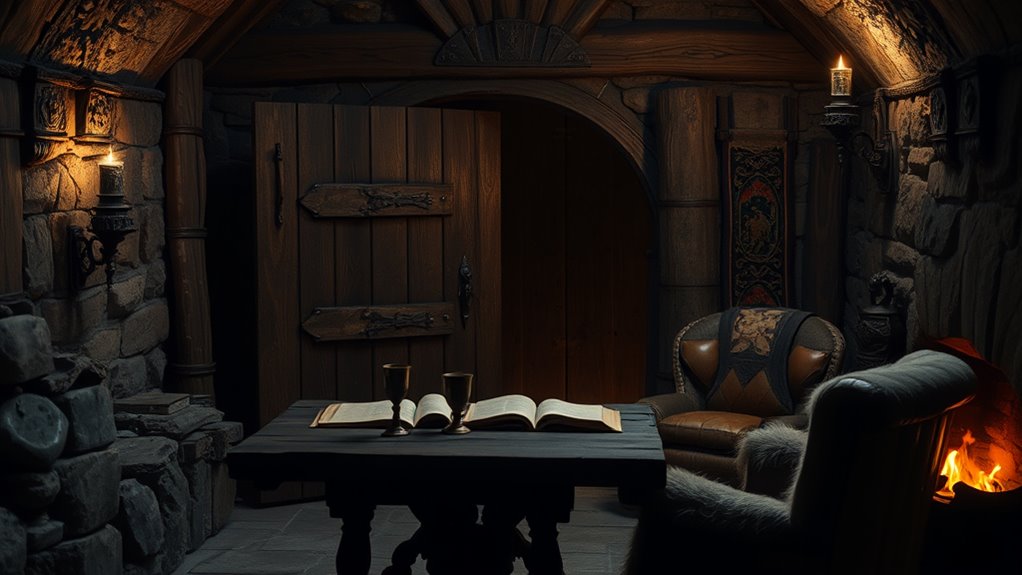
During the medieval period, castles and secret chambers became essential spaces for relaxation, strategy, and privacy within the often tumultuous world of knights and nobles. You’d find medieval fortresses equipped with hidden rooms and secret passages, designed to keep important figures safe or provide discreet escape routes. These secret chambers served as private retreats where you could relax away from courtly duties or plan your next move in political or military conflicts. Hidden corridors and concealed doors allowed you to move unseen, ensuring safety and privacy in turbulent times. These covert spaces weren’t just practical—they also symbolized power and control, giving you a sense of security and exclusivity within the imposing walls of your fortress. Understanding the security features of these chambers highlights their importance in maintaining safety and authority during a period marked by frequent conflicts.
Renaissance and Enlightenment: Private Studies and Libraries
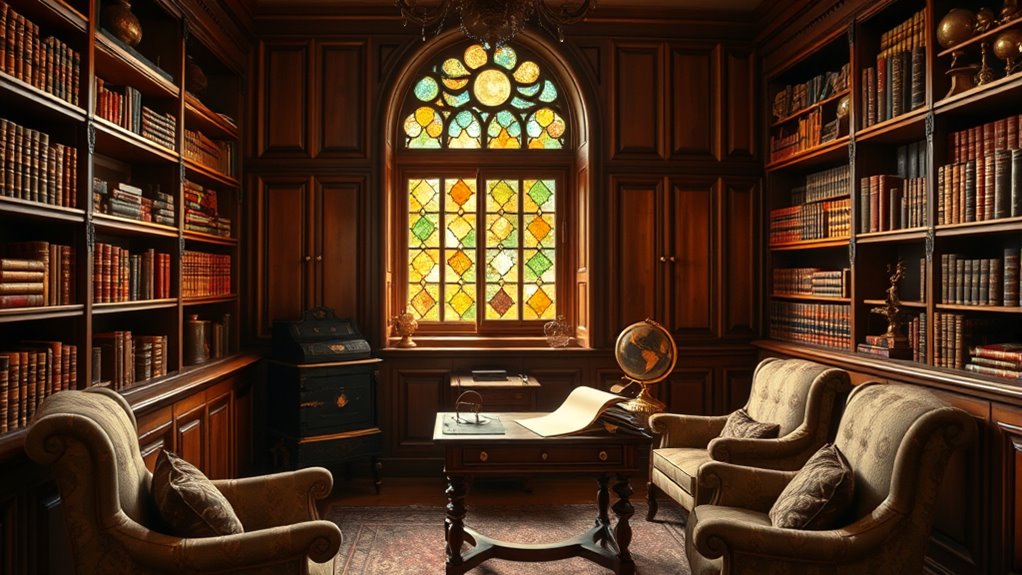
As the Renaissance and Enlightenment eras unfolded, intellectual pursuits took center stage within the walls of personal studies and libraries. You’d find individuals gathering in literary salons or philosophical circles, fueling debates and exchanging ideas. These private spaces became symbols of learning and curiosity, often filled with books, manuscripts, and art. Wealthy patrons and scholars dedicated rooms to reading, writing, and reflection, fostering a culture of inquiry. The rise of printed books made knowledge more accessible, inspiring you to create your own library or study. These spaces weren’t just for study—they were places where ideas flourished, and minds expanded beyond traditional boundaries. Your personal study during this time became a hub for knowledge dissemination, discussion, and the pursuit of truth.
The Industrial Revolution and the Rise of Personal Spaces
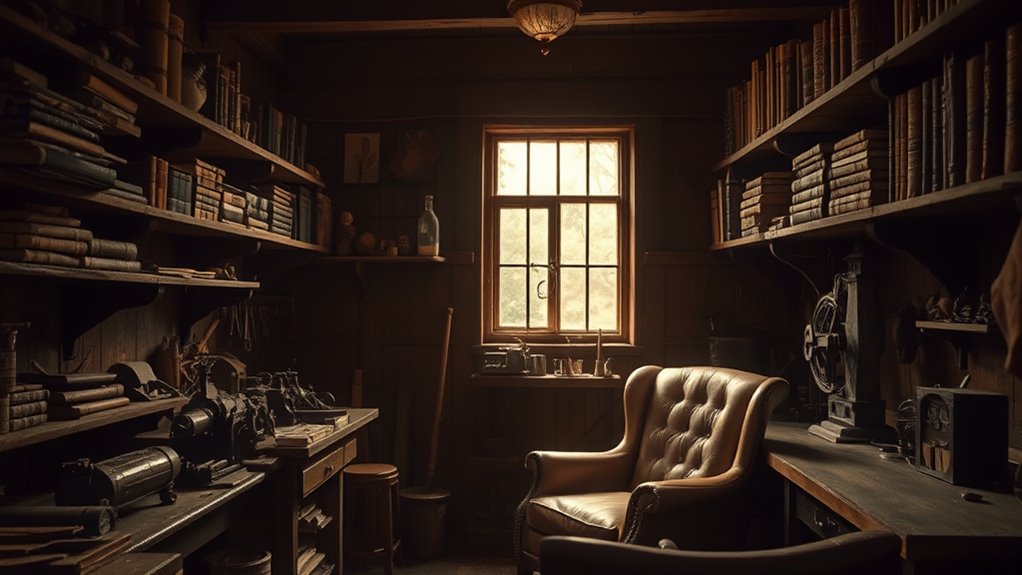
The Industrial Revolution transformed the way people dedicated spaces for personal pursuits, making private retreats more attainable and functional. Industrial innovation introduced new tools and furniture, allowing you to create cozy, personalized spaces at home. Urbanization impacts meant more people lived in crowded cities, inspiring the need for private areas to escape noise and chaos.
Consider these key developments:
- The rise of dedicated rooms, like home workshops or libraries, for hobbies and relaxation.
- The advent of affordable furniture, making personal spaces more accessible.
- Increased emphasis on privacy, as urban living demanded personal refuges amid bustling environments.
This era marked the beginning of spaces designed solely for your leisure, giving birth to the concept of modern personal retreats.
20th Century: The Birth of the Modern Man Cave
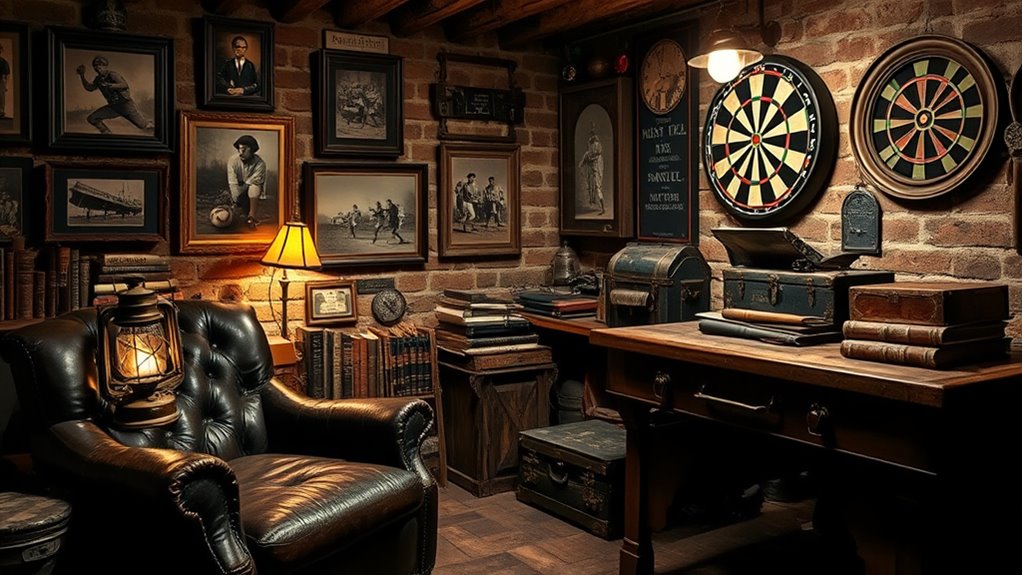
After World War II, men began carving out dedicated spaces as masculine retreats, reflecting a desire for personal comfort. The rise of entertainment technology transformed these rooms into hubs for watching TV, listening to music, and gaming. Technological advances continually shape the modern man cave, making it a dynamic and personalized sanctuary. Additionally, the incorporation of technology for entertainment has further evolved the space, allowing for more sophisticated and customizable experiences.
Post-War Masculine Retreats
Following World War II, men increasingly transformed spare rooms and basements into personal retreats, marking the true emergence of the modern man cave. This shift reflected a desire for a masculine space, similar to medieval guilds where craftsmen gathered or ancient rituals that honored tradition. Here’s what fueled the trend:
- Personal Identity: Men sought spaces to express hobbies and masculinity without outside interference.
- Post-War Prosperity: Economic growth allowed upgrades to homes, including dedicated retreats.
- Cultural Shifts: The era emphasized individualism, making the man cave a symbol of independence and personal achievement.
These retreats became more than just hideaways—they embodied a modern, private space rooted in historical notions of brotherhood and ritual, echoing the traditions of ancient guilds and rituals.
Rise of Entertainment Spaces
As technology advanced in the late 20th century, entertainment spaces within man caves transformed from simple hobby rooms into immersive multimedia hubs. Digital streaming revolutionized how you access movies, shows, and music, turning your space into a personalized entertainment center. Gaming setups became more sophisticated, with high-definition screens, surround sound systems, and specialized furniture designed for comfort during long sessions. You could now enjoy a cinematic experience or competitive gaming right from your own retreat. These technological upgrades made your man cave more than just a place for hobbies; it became a sanctuary for relaxation and entertainment. The focus shifted from basic equipment to creating an environment that immerses you in your favorite content, elevating the modern man cave into a true entertainment space. High-definition screens and advanced audio systems have further enhanced the immersive experience.
Technological Influences Emerge
The rapid pace of technological innovation in the 20th century sparked a revolution in how men create and customize their retreat spaces. You now have access to cutting-edge tools that transform a simple room into a high-tech sanctuary.
- Virtual reality headsets immerse you in new worlds, making your man cave a personal escape for gaming and relaxation.
- Advanced gaming setups with large screens and surround sound elevate your entertainment experience to theater-level quality.
- Smart home technology allows you to control lighting, climate, and audio with a single voice command or app, creating a seamless environment.
- Understanding the Vortex can help you cultivate a mindful and balanced approach to designing your space, fostering emotional well-being and inner peace.
These innovations make your man cave more than just a space; it becomes an interactive hub tailored to your interests. Technology truly accelerates the evolution of your personal retreat.
Cultural Influences and the Man Cave’s Global Spread
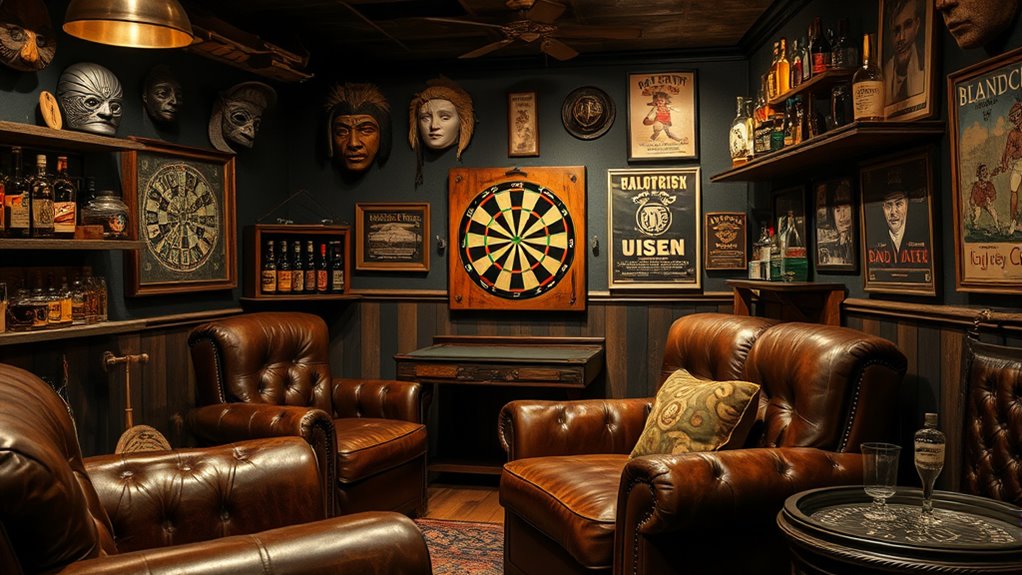
You’ll notice that different cultures create their own versions of retreats, reflecting local values and traditions. As the idea of a personal space spreads globally, more people adopt and adapt these concepts to fit their lifestyles. Exploring these trends reveals how the man cave’s concept evolves across borders and societies. Additionally, the influence of organization and storage practices helps maintain these spaces functional and clutter-free, enhancing their role as personal retreats.
Cultural Variations in Retreats
While the concept of a personal retreat varies across cultures, the idea of creating a space for relaxation, reflection, or leisure has resonated worldwide. Different societies incorporate unique cultural rituals and societal taboos into their retreats, shaping how they design and use these spaces. For example:
- In Japan, traditional tea rooms serve as tranquil retreats rooted in cultural rituals promoting mindfulness.
- In Middle Eastern cultures, private courtyards often function as personal sanctuaries, respecting societal taboos around privacy and modesty.
- Indigenous communities worldwide may create retreats that honor spiritual practices, blending cultural rituals with personal reflection.
- The support hours for entertainment venues like parks and amusement parks can influence when people choose to visit their retreats, especially during peak seasons or special events.
These variations highlight how cultural influences shape personal retreats, making each space a reflection of societal values and traditions.
Global Adoption Trends
As the concept of personal retreats gains popularity worldwide, the man cave has transcended its American origins to influence cultures across the globe. The globalization impact has facilitated this spread, allowing diverse societies to adopt and adapt the idea to their unique cultural contexts. In many countries, the man cave has undergone cultural adaptation, blending local traditions with the core concept of a personal sanctuary. For example, some cultures incorporate traditional crafts or regional decor, making the space more relatable. Additionally, the integration of unique and wicked planters and other personalized decor elements helps reflect regional tastes within these spaces. This global trend reflects a shared desire for personal space and leisure, regardless of cultural background. As a result, the man cave’s influence grows, demonstrating how a simple idea can evolve and resonate across different societies through globalization impact and cultural adaptation.
Technological Advances and the Evolution of Man Caves
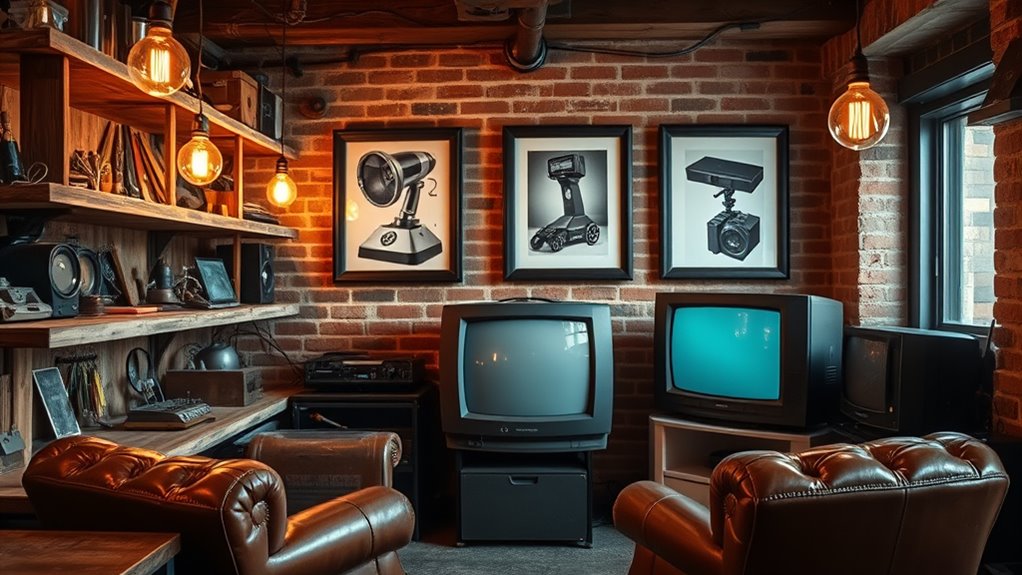
Technological advances have profoundly transformed the man cave, turning it from a simple retreat into a high-tech sanctuary. With innovations like virtual reality, you can now immerse yourself in gaming or sports experiences right from your space. Smart home technology allows you to control lighting, temperature, and sound with a tap or voice command, creating the perfect atmosphere effortlessly. Here are three key developments:
Technological advances turn your man cave into a high-tech haven with immersive VR, smart automation, and premium displays.
- Virtual reality setups for immersive entertainment and simulation experiences.
- Smart home integrations that automate climate control, lighting, and security.
- High-definition displays and surround sound systems enhancing your viewing pleasure.
- The integration of AI-driven solutions is beginning to optimize environmental settings and content recommendations, making your man cave more intuitive and personalized.
These advancements make your man cave a personalized haven, combining comfort with cutting-edge technology to elevate your leisure and relaxation.
The Man Cave Today: Tradition, Trends, and Personal Expression
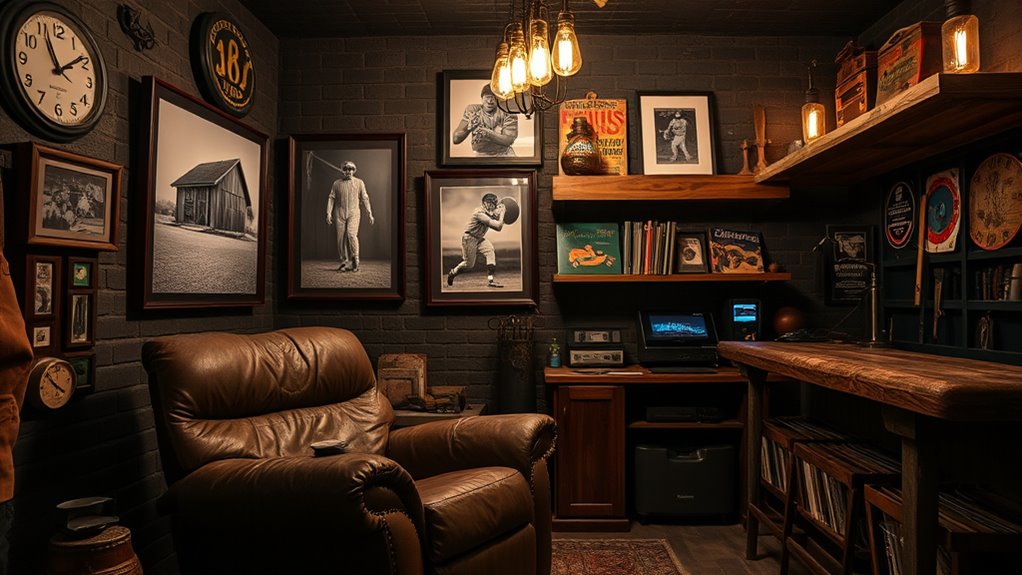
Today’s man caves blend tradition with trend, reflecting personal style and interests more than ever before. You can showcase your personality through carefully chosen decorative accessories, from vintage signs to modern artwork. Color schemes now range from bold, dark hues to soft pastels, allowing for versatile expression. Personal touches make your space unique, whether it’s sports memorabilia or a sleek bar setup. Consider this table to understand how tradition and trend merge:
| Tradition | Trend |
|---|---|
| Classic wood finishes | Industrial metal accents |
| Vintage collectibles | Modern tech gadgets |
| Leather furniture | Minimalist design |
| Warm lighting | LED color-changing lights |
| Personal memorabilia | Eco-friendly decor |
Your man cave becomes a reflection of your evolving style and passions.
Frequently Asked Questions
How Have Man Caves Influenced Modern Interior Design Trends?
You’ve probably noticed that man caves have shaped modern interior design trends by emphasizing personal space, comfort, and style. They inspire luxury furnishings and a focus on minimalist aesthetics, making spaces both functional and stylish. This influence encourages you to create versatile, personalized environments that blend practicality with sophistication, reflecting your unique taste. As a result, contemporary interiors often incorporate these elements, making your home feel more curated and tailored to your lifestyle.
Are There Any Famous Historical Figures Known for Private Retreats?
Imagine stepping into the secret worlds of famous hermitages and royal retreats—places where history’s giants sought solace. Figures like Henry VIII’s private chambers or the hermit Saint Anthony’s tranquil cell reveal that private retreats have long fascinated leaders and mystics alike. These spaces served as sanctuaries for reflection and power, proving that even the most influential personalities valued their personal hideaways for peace, strategy, and inspiration.
What Materials Were Traditionally Used to Build Ancient Man Caves?
You’d find that ancient man caves were built using materials like stone structures and natural caves. People used locally available stones to create durable shelters, often choosing natural caves for their protection and insulation. These materials provided safety from the elements and predators, making them ideal early retreats. By utilizing stone and existing caves, early humans established comfortable, lasting spaces for rest, ritual, and refuge.
How Do Cultural Differences Shape the Concept of a Man Cave?
You see, cultural differences heavily influence what a man cave represents. In some cultures, gender roles shape the space into a personal retreat, emphasizing masculinity and privacy. Cultural rituals also dictate decor and activities, making each man cave unique. You might find symbols of tradition or modern hobbies reflecting societal values. These differences show how the concept adapts worldwide, blending personal preferences with cultural expectations to create a space just for you.
What Role Do Man Caves Play in Contemporary Social Relationships?
Ironically, your man cave might be more about social bonding than solitude. It plays a unique role in contemporary relationships by shaping gender dynamics, offering a space where men can unwind and connect. This retreat fosters camaraderie, strengthens friendships, and even helps navigate modern gender expectations. So, instead of isolating, your man cave becomes a hub for meaningful interactions, proving that sometimes, solitude fuels stronger social ties.
Conclusion
Did you know that over 60% of men today consider their man cave a essential space for relaxation and personal expression? From ancient secret chambers to modern retreats, the man cave has evolved but always served as your private sanctuary. It’s a reflection of your personality and a space where you can unwind and recharge. So, whether it’s history or trend, your man cave continues a timeless tradition of creating your perfect escape.
